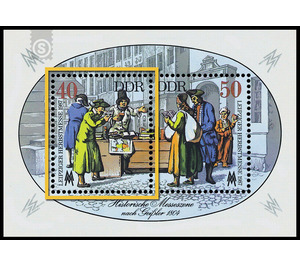Commemorative stamp series - Germany / German Democratic Republic 1987 - 40 Pfennig
Theme: Calender
| Country | Germany / German Democratic Republic |
| Issue Date | 1987 |
| Face Value | 40.00 |
| Color | multi-colored |
| Perforation | Ks 13 1/4 |
| Printing Type | offset |
| Stamp Type | Postage stamp |
| Item Type | Stamp |
| Chronological Issue Number | 2862 |
| Chronological Chapter | GER-DDR |
| SID | 767410 |
| In 12 Wishlists | |
Leipziger Herbstmesse 1987 On the occasion of the Leipzig Autumn Fair in 1987, the Ministry of Posts and Telecommunications of the German Democratic Republic issues a multi-colored special postage stamp block with two special postage stamps. Special cancellation from August 25 to October 24, 1987 Leipzig Autumn Fair 1987 The more than 820-year history of the Leipzig Fair is recorded in many annals, chronicles and journals in the word. Unfortunately, there are very few picture documents from the times before the invention and the spread of photography. One of the few artists who portrayed the activities of the Leipzig trade fair in past centuries in their works, so that we can now form a visual idea of it, was Christian Gottfried Heinrich Geißler. On his copper engraving on the street trade to the Leipzig fair refers to the motive designed by Mr. Scheuner "historical fair scene after Geissler 1804". For centuries, the Leipzig Trade Fair played mainly on the street. In shops and stalls merchants offered their products during the time of the goods fair, as can be seen on the postage stamps. Exhibition houses did not appear until the end of the 19th century and were initially called trade fair palaces because of their pompous design. Leipzig also played a pioneering role in this field: in 1894, the first "Städtische Kaufhaus" was opened exclusively for trade fair purposes. The exhibition center with its huge halls and extensive open spaces was only built in 1920. The draftsman and engraver Christian Gottfried Heinrich Geißler is the first image reporter at the Leipzig Trade Fair. Geißler lived from 1770 to 1841 in Leipzig. He was educated at the then still young and led by Adam Friedrich Oeser drawing academy. As a twenty-year-old Geissler went to Petersburg and made with the Russian Council of State, scholars and naturalists Dr.. Pallas an expedition through southern Russia and the South Asian regions of the Russian Empire. Returning to Leipzig in 1798, he and Pallas published several great works of art about his travels with his brother-in-law, the publisher Gottfried Martini. Inspired by this success Geissler created in the following years numerous graphic works on behalf of various publishing houses in Leipzig. In 1804/05 he supplied engravings for the "Leipziger Messeszenen" of E. F. Steinacker. Twelve motifs appeared in three notebooks, one each for the two fairs of the year 1804 and the last one for the Easter Mass in 1805. In this cycle Geissler recorded very characteristic moments of the colorful exhibition. He presented both the market and the street trade, as well as the exotic-looking foreigners and the amusement locals, the merrymaking on different places in the city and much more. Apart from this uniquely outstanding series of images, Geißler has repeatedly taken to the end of his life in graphic cut sheets of the fair. So he became a true chronicler of his time, the chronicler of the fair city Leipzig. On the block for the Leipzig Autumn Fair in 1987 again the sign of the Leipzig Trade Fair, the double "M", is depicted. This sign is now 70 years, it was first used for the Leipzig Fair in 1917. It was designed by the Leipzig painter and graphic artist Erich Gruner (1881 - 1966). The two superimposed "M" symbolize the term "Mustermesse", which was developed in Leipzig.Through the seventy years of its existence, the meanwhile world-famous symbol has been repeatedly modified according to contemporary tastes World Trade Square in the German Democratic Republic around the globe.


